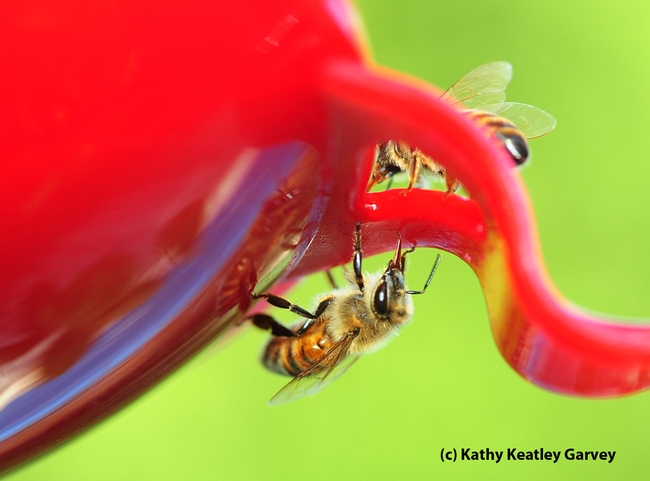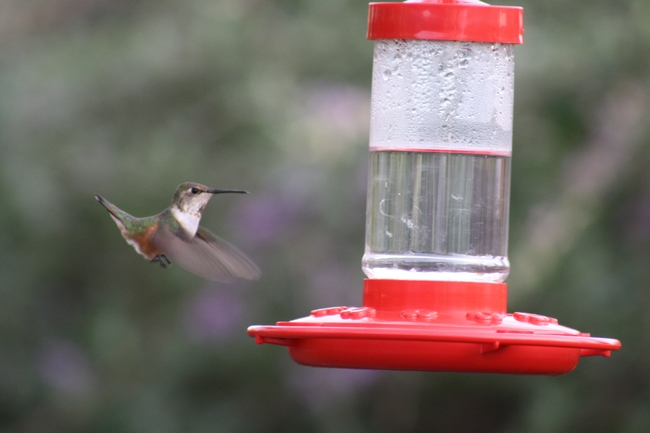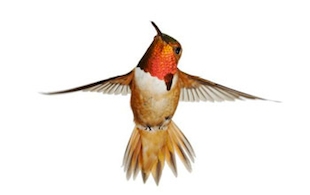Posts Tagged: hummingbirds
Dining Where They're Not Wanted
If your hummingbird feeders are filled with that oh-so-tantalizing sweet sugary syrup, you may be attracting not only hummers, but honey bees, too....

Honey bees licking the surface of a hummingbird feeder. (Photo by Kathy Keatley Garvey)

Hummers can reach this syrup but the bees cannot. (Photo by Kathy Keatley Garvey)
Hummingbirds and Other Thoughts
Anybody out there who doesn’t like to watch hummingbirds as they flit through the yard? If that’s you, read no farther but just skip to the last paragraph or two. If you’re like me,
however, continue to read.
Folks like hummingbirds for a variety of reasons: they are entertaining; they are fearless in defending their territory and feeders from others (including hummingbirds who are
“strangers”, and for those of you who like nature photography, they are quite the challenge. The photo hint first: try to entice birds to a colorful, single flower and be there, waiting, with your camera on a stable mounting or tripod. Try to chase any bird around the yard for a picture just doesn’t work!
To get hummingbirds to come into the yard and stay there requires a few items: a feeder, of course; a place to just sit and rest the old wings for a moment or two (the hint here can be as simple as hanging a wire coat hanger near the eaves of your home)—how low-tech is that?; and a suet cage filled with scraps of yarn and string for nesting material, a kind of a “one-stop" nest materials store. Let a few dandelions go to seed, hummers use the seeds to line their nests. Add a lot of hummingbird-friendly plants and you’re pretty much done.
Now as for keeping them there: full tummies make for staying birds. A special treat that’s not put out there often is overripe cantaloupes. Hummingbirds will devour that tasty treat and you don’t waste. Another thought: remember your successes from past seasons or those things that worked for your friends. Cannas, Bee balm, Gilia flowers, etc. Stick with what worked, and don’t bother wasting money trying other plants –unless you wanted to have those choices in your yard anyway. GO RED! Just about anything that’s red will draw hummers. To get them to notice new feeders, attach leftover red ribbons, pieces of scarves, even “el fako” flowers will work. Once the little guys find the feeder, they will return!
Speaking of feeders, make your own “nectar” and save some money. All it takes to make the goodies is 4 parts water to 1 part sugar. Boil it, cool it, and fill your feeder(s). No need to add the red food coloring, especially if the feeder is red. If the feeder is in the shade, you’ll have less algae growth so the sugar water won’t need changing as often.
I don’t put out hummingbird feeders in my yard as the neighborhood cats, both feral and tame, seem to think that my large backyard is theirs for the using since my dog is gone. My own cats enjoy watching the birds out in the tree at the window. I don’t know what the cats really are saying but it sound suspiciously like “Here, birdie, birdie!”. Oh well, I guess I’m not the only one who enjoys watching the birds !
On a different note, the Sacramento Cactus and Succulent Society just had the annual spring sale at the Shepherd Garden & Art Center across the street from McKinley Park ( 3330 McKinley Blvd) in Sacramento last week-end. If you are interested in joining or finding out more about this group call: George & Oskun Avery at 916-682-8397 or email
gravery2@Comcast.net. The group meets the 4th Monday of the month, except in Dec. Dues are $15 per person or $20 per family.

Hummingbird coming in to feed. (photos by Jennifer Baumbach)

Rufous hummingbird on Rosa banksiae.
Hummingbirds are noisy romancers
Forget bird watching; next time you spot a hummingbird, listen.
Most of us pause to gaze at the tiny birds’ impressive mid-air hovering, part of their hunting behavior, but males of some hummingbird species generate loud sounds with their tail feathers while courting females.
Now, for the first time, the cause of these sounds has been identified: a paper published in the Sept. 9, 2011, issue of Science reveals that air flowing past the tail feathers of a male hummingbird makes his tail feathers flutter and thereby generate fluttering sounds.
Watch a video of hummingbird tail feathers in an wind tunnel.
Male hummingbirds only produce fluttering sounds during their elaborate courtship rituals. Typically, during such a display, a male hummingbird will climb into the air five to 40 meters, and then quickly dive-bomb down past a perched female; when the courting male bird reaches the lowest point of his dive, he rapidly spreads and then closes his tail feathers. This spreading exposes the tail feathers to air, which causes them to flutter and generate sound, according to Christopher Clark of Yale University, lead author of the study.
Clark's research, which he began as a graduate student at the University of California, Berkeley, shows that the males of each hummingbird species have their own signature sound — largely determined by whether and how the fluttering frequencies of its different tail feathers interact with one another and blend together.
Other factors, such as the size, shape, mass and stiffness of the hummingbird's feathers, also help determine the tone of each species' particular sound.
In addition to diving during courtship rituals, a male hummingbird may also brandish showy ornaments and produce sounds from other feathers besides his tail feathers.
All this, just to impress that special lady.
Clark analyzed the fluttering sounds of hummingbird feathers by measuring the fluttering feathers with a Scanning Laser Doppler Vibrometer — an instrument that is used to measure the vibrations of a surface — and by viewing high speed videos of the tail feathers of hummingbirds in a wind tunnel.
The study was co-authored by Damian Elias, also of UC Berkeley.
— Adapted from a story by the National Science Foundation.


